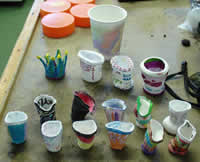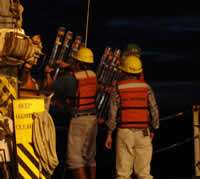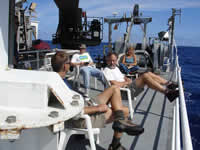


|
The Project Part 3:
Also See: Part 1: Part 2:
|
September 5, 2005
Deep Down Laughter Today we got to make a deep cast. They went down to 1500 meters (convert that to feet), and then captured some water samples on the way back up. This is not a cast that studies the coccolithophores, since they don't live that deep. Instead, this cast was to look at levels of nitrous oxide, or better known to you and me as "laughing gas." It occurs naturally deep in the ocean, and then gets released into our atmosphere. Why should we care about levels of nitrous oxide in our atmosphere? Well, because it eats ozone, and it is a very powerful greenhouse gas, much better at trapping heat than carbon dioxide. This could have an effect on global warming. During this cast, I got a chance to attach some decorated styrofoam cups. They shrink when taken down to that level because the air gets pushed out of them by the increasing pressure of the water as it gets deeper. Sometimes the bubble or warp a little as the air comes out unevenly, but the effect is still quite interesting. I'm sure my students will enjoy their souvenirs. The scientists also brought in the second array of buoys this morning and ran their tests on this group of fertilized phytoplankton. Part of the array is a sediment trap, where they capture the stuff as it falls toward the ocean floor. That's how scientists figure out which things get to the ocean floor. We also did a "pump cast" today. That is when they send the CTD to a certain depth with a pump attached to it. Then they pump the water through for an hour and a half. They get all sorts of data during this time that they study afterward. It also provides for an hour and half of down time, and the scientists get a little time to go sit in the sun on the back deck. Note: The scientists would love to hear questions from you about the work they are doing, or oceanography in general. However, there seems to be a glitch with the Contact Us link, and I am not receiving the emails. Instead, email any questions you may have to this shipboard address: weniger@pigeon.shipops.orst.edu and I would be happy to email you back answers. This email will be active until 9-8-05. Math Questions: The Arctic tern has the longest migration of any bird, 24,000 miles from Antarctica to the Arctic every year. It takes 8 months to complete this migration, which averages out to 100 miles a day. The women's Olympic marathon record is 2 hours 24 minutes and 52 seconds to run 26 miles. How long would it take this woman to run the daily migration of 100 miles? Ocean Trivia: The Oxford Companion to Ships and the Sea has a very interesting entry about superstitions of sailors that still exist today. One such superstition in ancient days was when a ship was about to launch or sail on a long voyage, an offering of wine was required of the gods, so the sailors would pour wine on the deck in order that they should have good luck on their voyage. Today, we still break a bottle of wine or champagne across the bow when a new ship is launched, usually accompanied by the statement, "Bless this ship and all who sail her." Another old superstition is that to whistle in a calm will bring a wind, but to whistle on board when the wind is blowing will bring a gale.
|



